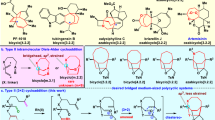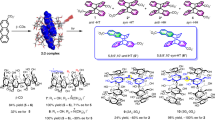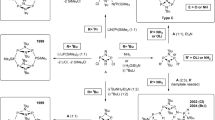Abstract
Methods to form cyclobutane rings by an intermolecular [2 + 2] cross-photoreaction (CPR) with four different substituents are rare. These reactions are typically performed in the liquid phase, involve multiple steps, and generate product mixtures. Here, we report a CPR that generates a cyclobutane ring with four different aryl substituents. The CPR occurs quantitatively, without side products, and without a need for product purification. Generally, we demonstrate how face-to-face stacking interactions of aromatic rings can be exploited in the process of cocrystallization and the field of crystal engineering to stack and align unsymmetrical alkenes in CPRs to afford chiral cyclobutanes with up to four different aryl groups via binary cocrystals. Overall, we expect the process herein to be useful to generate chiral carbon scaffolds, which is important given the presence of four-membered carbocyclic rings as structural units in biological compounds and materials science.
Similar content being viewed by others
Introduction
Recent years have witnessed efforts to perform organic syntheses that are efficient, atom economical, and sustainable1. In this context, the ability to achieve an intermolecular [2 + 2] cross-photoreaction (CPR) to form a four-membered cyclobutane ring system with four different substituents—vis a vis a stereogenic carbon atom2—that occurs quantitatively and without side products represents an important and fundamental synthetic challenge (Fig. 1)3,4,5. In such a reaction, two unsymmetrical carbon–carbon double (C=C) bonds on two different molecules are expected to be assembled and preorganized parallel and in close proximity to photoreact.
Alkenes functionalized with perfluorophenyl (i.e., fully fluorinated) groups, along with phenyl-, and/or carboxylic acid groups, are known to undergo rare CPRs in the solid state6 upon cocrystallization7,8,9,10,11,12. For a photocycloaddition to occur in the solid state, two alkenes are expected to crystallize in a parallel arrangement with the C=C bonds separated on the order of 4.2 Å13. While the CPRs involving the perfluorophenyl groups6 have generated aryl-substituted cyclobutanes with up to three different substituents6,12, the formation of a cyclobutane ring with four different substituents has remained elusive. CPRs also occur in the solid state in statistical mixtures of solid solutions14,15,16, although an example of two different unsymmetrical alkenes assembling in a cocrystal that react in a CPR to form a cyclobutane with four different aryl groups quantitatively and without side products has not been reported.
Our solution to the aforementioned problem is to use four different functional groups that support two different face-to-face stacking interactions; namely, perfluorophenyl-phenyl and H-perfluorophenyl-pyridyl stacking to direct the assembly of C=C bonds to react (Fig. 2)13. We hypothesized that the partially fluorinated phenyl groups present in the symmetrical alkene trans-1,2-bis(2,3,5,6-tetrafluorophenyl)ethylene (8F) would have a capacity to participate in face-to-face stacking with phenyl groups, akin to a fully fluorinated analog17. Density functional theory (DFT) calculations demonstrated bond polarization and significant partial positive charges on the ring C-atoms of the C–F bonds of 8F (Fig. 3). Such polarization supports stacking of fully fluorinated groups via perfluorophenyl-phenyl forces, and we expected the idea could be applied to the partially fluorinated analog 8F18. DFT calculations also showed the end C–H groups to be polarized, having—in contrast—partial negative and positive charges on the C- and H-atoms, respectively. The fluorophenyl-bearing alkenes symmetrical 8F and unsymmetrical trans-1-(2,3,5,6-tetrafluorophenyl)-2-(2,3,4,5,6-pentafluorophenyl)ethylene (9F) were, thus, used. Symmetrical trans-stilbene (SB) and unsymmetrical trans-4-stilbazole (SBZ) were used as the phenyl-bearing alkenes. Symmetrical trans-1,2-bis(4-pyridyl)ethylene (BPE) was also a reactant.
Results and discussion
The symmetrical and partially fluorinated alkene 8F was prepared by a Wittig reaction. When 8F (25 mg, 0.077 mmol) in toluene (2.0 mL) was cocrystallized with SB (14 mg 0.077 mmol) in toluene (2.0 mL), colorless plate-shaped single crystals of the binary cocrystal SB·8F formed upon slow evaporation after a period of 2 days. The components of SB·8F crystallize in the centrosymmetric triclinic space group P ī (Table 1, Fig. 4) (Supplementary Data 1). The two alkenes participate in offset face-to-face π-stacking to form stacked columns, with 8F of adjacent columns aligned end-to-end and interaction by means of C–H···F forces (Fig. 4a). Within each column, SB and 8F stack in an alternating fashion and in registry17. The C=C bonds of the stacked molecules lie parallel and separated by 3.82 Å (centroid···centroid), which conforms to the criteria of Schmidt. When the cocrystal SB·8F was exposed to UV-radiation (medium-pressure Hg lamp) for a period of 50 h, the two alkenes reacted in an intermolecular CPR to form SB-8F-cb (chiral C2 symmetric) in quantitative yield. Cyclobutane formation was evidenced by the disappearance and appearance of the multiplets at 7.94 and 7.61 ppm, respectively.
The stereochemistry of SB-8F-cb was confirmed by single-crystal X-ray diffraction (Fig. 4b) (Supplementary Data 2). When the as-photoreacted powder was dissolved in toluene (1.0 mL) and ethanol (1.0 mL), colorless block crystals formed, upon slow evaporation. The cyclobutane product SB-8F-cb crystallizes in the triclinic space group P ī to form a layered structure within the crystallographic ab-plane. The centrosymmetric space group is consistent with the photodimerization affording a mixture of two enantiomers in equal amounts from the reacting solid. The cyclobutane exhibits a tongue-in-groove fit sustained by offset face-to-face H-perfluorophenyl-phenyl forces (3.88 Å).
A CPR of 8F was also achieved with the symmetrical bipyridine BPE. When 8F (25 mg, 0.077 mmol) in toluene (2.0 mL) was cocrystallized with BPE (14 mg, 0.077 mmol) in toluene (1.0 mL) and ethanol (1.0 mL), colorless plate-shaped single crystals of BPE·8F formed upon slow evaporation after a period of 2 days. The components of BPE·8F also crystallize in the centrosymmetric triclinic space group P ī (Table 1, Fig. 5) with the alkenes in offset face-to-face π-stacking geometries (Supplementary Data 3). The C=C bonds of the stacked molecules are parallel and separated by 3.85 Å (Fig. 5a). Both end pyridyl N-atoms of BPE also participate in rare C–H···N type hydrogen bonds (3.30 Å) with 8F to afford one-dimensional (1D) arrays. Thus, in contrast to SB·8F, the 1D columns are offset. The 1D arrays assemble such that the alkenes are also engaged in alternating face-to-face stacks. When the cocrystal BPE·8F was exposed to UV-radiation for a period of 50 h, BPE-8F-cb (chiral C2 symmetric) formed in quantitative yield as evidenced by the disappearance and appearance of the multiplets at 7.94 and 7.61 ppm, respectively. The stereochemistry of BPE-8F-cb was also confirmed by single-crystal X-ray diffraction with the cyclobutane crystallizing in the centrosymmetric space group P ī (Fig. 5b) (Supplementary Data 4).
The method also generates a cyclobutane ring with three different substituents. When symmetrical 8F (25 mg, 0.077 mmol) was cocrystallized with unsymmetrical SBZ (14 mg, 0.077 mmol) in toluene (1.0 mL) and ethanol (1.0 mL), colorless rectangular-shaped single crystals of the binary cocrystal SBZ·8F formed upon slow evaporation after a period of 2 days. The components of SBZ·8F crystallize in the centrosymmetric triclinic space group P ī with the alkenes face-to-face (Table 1, Fig. 6) (Supplementary Data 5). The C=C bonds lie parallel, and separated by two unique distances of 3.81 and 3.85 Å (Fig. 6a). The olefins stack with the aromatic rings engaged in a combination of H-fluorophenyl-phenyl and H-fluorophenyl-pyridyl forces. The pyridyl N-atoms of SBZ also participate in C–H···N type hydrogen bonds (3.28 Å) with 8F to define a two-component complex of offset columns. When SBZ·8F was exposed to UV-radiation for a period of 50 h, SBZ-8F-cb (chiral C1 symmetric) formed in quantitative yield. The stereochemistry of SBZ-8F-cb was confirmed by single-crystal X-ray diffraction with the cyclobutane crystallizing in the centrosymmetric triclinic space group P ī (Fig. 6b) (Supplementary Data 6).
Whereas stacking of fully fluorinated aromatic rings with phenyl groups is known, we are unaware of an example that uses partially fluorinated rings to achieve such face-to-face stacking in a cocrystal. Moreover, that the rings of 8F participate in stacks with both a phenyl- and a pyridyl-group prompted us to turn to form a cyclobutane ring with four different substituents. We expected that cocrystallization of the unsymmetrical alkenes 9F and SBZ would generate a binary cocrystal wherein the two alkenes assemble in a face-to-face stacked geometry. While two orientations of the stacked alkenes would be possible, perfluorophenyl-phenyl stacking was expected to be favored based on complementary electrostatics19. A cocrystallization of 9F and SBZ would, thus, afford a binary cocrystal with the olefins stacked face-to-face (Fig. 2). A topochemical [2 + 2] photodimerization would generate the chiral cyclobutane SBZ-9F-cb (chiral C1 symmetric) that bears four chemically different substituents.
The unsymmetrical alkene 9F was prepared by a Wittig reaction. When 9F (25 mg, 0.073 mmol) in toluene (2.0 mL) was cocrystallized with unsymmetrical SBZ (13 mg, 0.073 mmol) in toluene (1.0 mL) and ethanol (1.0 mL), colorless plate-shaped single crystals of the binary cocrystal SBZ·9F formed upon slow evaporation after a period of 2 days. The components of SBZ·9F crystallize in the centrosymmetric triclinic space group P ī (Tables 1 and 2, Fig. 7) with the alkenes in offset face-to-face π-stacked geometries (Supplementary Data 7). The C=C bonds lie parallel and separated by two unique distances of 3.79 and 3.90 Å. The olefins stack with the aromatic rings engaged in a combination of perfluorophenyl-phenyl and H-perfluorophenyl-pyridyl forces. The end pyridyl N-atoms of SBZ, as in BPE·8F, participate in C–H···N hydrogen bonds (3.30 Å) to form two-component complexes of offset columns (Fig. 7a). The perfluoronated rings of 9F also interact between columns by F···F forces (2.94 Å). When SBZ·9F was exposed to UV-radiation for a period of 50 h, the cyclobutane with four different aryl substituents SBZ-9F-cb (chiral C1 symmetric) formed in quantitative yield. The formation of SBZ-9F-cb was evidenced by the disappearance and appearance of the alkene and cyclobutane resonances, respectively (Fig. 8).
The stereochemistry of SBZ-9F-cb was confirmed by single-crystal X-ray diffraction (Fig. 7b) (Supplementary Data 8). Specifically, while SBZ-9F-cb resisted crystallization from a number of different organic solvents, reaction of SBZ-9F-cb with p-toluenesulfonic acid in dichloromethane-methanol (2 mL, 1:1, v:v) afforded single crystals of the salt [H-SBZ-9F-cb][p-TsO]. The components crystallize in the centrosymmetric monoclinic space group P21/n. The X-ray data confirm attachment of the four different substituents and stereochemistry of the cyclobutane ring system of SBZ-9F-cb. The components assemble to form a channel-type solid with the cyclobutanes forming ribbons along the crystallographic a-axis.
In this report, we have demonstrated how principles of crystal engineering and supramolecular chemistry can be used to construct a cyclobutane with four different substituents. The cyclobutane photoproduct, along with other generated chiral cyclobutanes, forms quantitatively, without side products, and without a need for purification. The process is remarkable, given the facile manner in which all products form compared to liquid phase approaches. In experiments to further widen the scope, we expect the process to be useful to generate additional carbon scaffolds that are relevant to biologically important compounds and materials science. These ideas are also important to further efforts that focus to transiently trap compounds and control chemical reactivity 20.
Methods
Chemicals
Triphenylphosphine (Strem) 2,3,5,6-tetrafluorobenzyl bromide (Oakwood), 2,3,4,5,6-pentafluorobenzyl bromide (Oakwood), 2,3,5,6-tetrafluorobenzaldehyde (Oakwood), 2,3,4,5,6-pentafluorobenzaldehyde (Oakwood), sodium hydride (dry, Sigma-Aldrich), BPE (Sigma-Aldrich), SB (ACROS), and solvents (toluene, chloroform, ethanol, dimethylformamide) (Fisher) were commercially available and used as received.
Photoreactions
All photochemical reactions were conducted using UV-radiation from a 450 W medium-pressure mercury lamp in an ACE Glass photochemistry cabinet. All cocrystals were finely ground using a mortar and pestle, and then placed between a pair of Pyrex glass plates. Samples were irradiated in 6-h intervals.
Syntheses
For the syntheses and characterizations of triphenyl-(2,3,5,6-tetrafluorobenzyl)phosphonium bromide, 8F, SBZ, and 9F, as well as all cocrystals and products of photoreactions and CCDC codes (2042036-2042043), see Supplementary Methods.
Data availability
The X-ray crystallographic coordinates for structures of SB·8F, SB-8F-cb, BPE·8F, BPE-8F-cb, SBZ·8F, SBZ-8F-cb, SBZ·9F, and [H-(SBZ-9F-cb)][p-TsO] reported in this article have been deposited at the Cambridge Crystallographic Data Center (CCDC), under deposition numbers CCDC 2042036 to 2042043, respectively. These data can be obtained free of charge from The Cambridge Crystallographic Data Center via https://summary.ccdc.cam.ac.uk/structure-summary-form. Details of syntheses, NMR spectral data, and molecular modeling are provided in the Supplementary Material. All relevant data are available from the authors.
References
Zhou, Q.-Q., Zou, Y.-Q., Lu, L.-Q. & Xiao, W.-J. Visible-light-induced organic photochemical reactions through energy-transfer pathways. Angew. Chem. Int. Ed. 58, 1586–1604 (2019).
Prusov, E. V. Construction of Quaternary Stereogenic Centers in the total synthesis of natural products. Angew. Chem. Int. Ed. 56, 14356–14358 (2017).
Inanaga, K., Takasu, K. & Ihara, M. A practical catalytic method for preparing highly substituted cyclobutanes and cyclobutenes. J. Am. Chem. Soc. 127, 3668–3669 (2005).
Liu, R. et al. Stereoselective preparation of cyclobutanes with four different substituents: total synthesis and structural revision of pipercyclobutanamide A and piperchabamide G. Angew. Chem. Int Ed. Engl. 51, 7503–7506 (2012).
Suzuki, T., Fukushima, T., Yamashita, Y. & Miyashi, T. An absolute asymmetric synthesis of the [2 + 2] cycloadduct via single crystal-to-single crystal transformation by charge-transfer excitation of solid-state molecular complexes composed of Arylolefins and Bis[1,2,5]thiadiazolotetracyanoquinodimethane. J. Am. Chem. Soc. 116, 2793–2803 (1994).
Coates, G. W. et al. Phenyl-perfluorophenyl stacking interactions: topochemical [2+2] photodimerization and photopolymerization of olefinic compounds. J. Am. Chem. Soc. 120, 3641–3649 (1998).
Mir, N. A., Dubey, R. & Desiraju, G. R. Strategy and methodology in the synthesis of multicomponent molecular solids: the quest for higher cocrystals. Acc. Chem. Res. 52, 2210–2220 (2019).
Bolla, G. & Nangia, A. Pharmaceutical cocrystals: walking the talk. Chem. Commun. 52, 8342–8360 (2016).
Nangia, A. K. & Desiraju, G. R. Crystal engineering: an outlook for the future. Angew. Chem. Int. Ed. 58, 4100–4107 (2019).
Grove, R. C., Malehorn, S. H., Breen, M. E. & Wheeler, K. A. A photoreactive crystalline quasiracemate. Chem. Commun. 46, 7322–7324 (2010).
Poplata, S., Tröster, A., Zou, Y.-Q. & Bach, T. Recent advances in the synthesis of cyclobutanes by olefin [2 + 2] photocycloaddition reactions. Chem. Rev. 116, 9748–9815 (2016).
Sharma, C. V. K. et al. 3-(3’,5’-Dinitrophenyl)-4-(2’,5’-dimethoxyphenyl)cyclobutane-1,2-dicarboxylic acid: engineered topochemical synthesis and molecular and supramolecular properties. Chem. Mater. 6, 1282–1292 (1994).
Schmidt, G. Photodimerization in the solid state. Pure Appl. Chem. 27, 647–678 (1971).
Bučar, D.-K., Sen, A., Mariappan, S. V. S. & MacGillivray, L. R. A [2+2] cross-photodimerisation of photostable olefinsvia a three-component cocrystal solid solution. Chem. Commun. 48, 1790–1792 (2012).
Theocharis, C. R., Desiraju, G. R. & Jones, W. The use of mixed crystals for engineering organic solid-state reactions: application to benzylbenzylidenecyclopentanones. J. Am. Chem. Soc. 106, 3606–3609 (1984).
Elgavi, A., Green, B. S. & Schmidt, G. M. J. Reactions in chiral crystals. Optically active heterophotodimer formation from chiral single crystals. J. Am. Chem. Soc. 95, 2058–2059 (1973).
Sinnwell, M. A., Ingenthron, B. J., Groeneman, R. H. & MacGillivray, L. R. Stereoselective and quantitative [2+2] photodimerization of a symmetrical octafluoro stilbene in the solid state: face-to-face stacking of the fluorinated rings in trans-1,2-bis(2,3,5,6-tetrafluorophenyl)ethylene. J. Fluor. Chem. 188, 5–9 (2016).
Ponzini, F., Zagha, R., Hardcastle, K. & Siegel, J. S. Phenyl/pentafluorophenyl interactions and the generation of ordered mixed crystals: sym-Triphenethynylbenzene and sym-Tris(perfluorophenethynyl)benzene. Angew. Chem. Int. Ed. 39, 2323–2325 (2000).
Edwards, A. J., Mackenzie, C. F., Spackman, P. R., Jayatilaka, D. & Spackman, M. A. Intermolecular interactions in molecular crystals: what’s in a name? Faraday Discuss. 203, 93–112 (2017).
Martinez-Cuezva, A., Lopez-Leonardo, C., Bautista, D., Alajarin, M. & Berna, J. Stereocontrolled synthesis of β-lactams within [2]rotaxanes: showcasing the chemical consequences of the mechanical bond. J. Am. Chem. Soc. 138, 8726–8729 (2016).
Acknowledgements
We are grateful for funding from Webster University in the form of Faculty Research Grants as well as the National Science Foundation (DMR-1708673 and CHE-1828117).
Author information
Authors and Affiliations
Contributions
R.H.G. and L.R.M. designed and conceived of the project. M.A.S., B.J.I., and C.L. performed the experiments. R.H.G. and L.R.M. wrote the manuscript. All authors approved the final version of the manuscript.
Corresponding authors
Ethics declarations
Competing interests
The authors declare no competing interests.
Additional information
Publisher’s note Springer Nature remains neutral with regard to jurisdictional claims in published maps and institutional affiliations.
Rights and permissions
Open Access This article is licensed under a Creative Commons Attribution 4.0 International License, which permits use, sharing, adaptation, distribution and reproduction in any medium or format, as long as you give appropriate credit to the original author(s) and the source, provide a link to the Creative Commons license, and indicate if changes were made. The images or other third party material in this article are included in the article’s Creative Commons license, unless indicated otherwise in a credit line to the material. If material is not included in the article’s Creative Commons license and your intended use is not permitted by statutory regulation or exceeds the permitted use, you will need to obtain permission directly from the copyright holder. To view a copy of this license, visit http://creativecommons.org/licenses/by/4.0/.
About this article
Cite this article
Sinnwell, M.A., Groeneman, R.H., Ingenthron, B.J. et al. Supramolecular construction of a cyclobutane ring system with four different substituents in the solid state. Commun Chem 4, 60 (2021). https://doi.org/10.1038/s42004-021-00493-3
Received:
Accepted:
Published:
DOI: https://doi.org/10.1038/s42004-021-00493-3
Comments
By submitting a comment you agree to abide by our Terms and Community Guidelines. If you find something abusive or that does not comply with our terms or guidelines please flag it as inappropriate.











